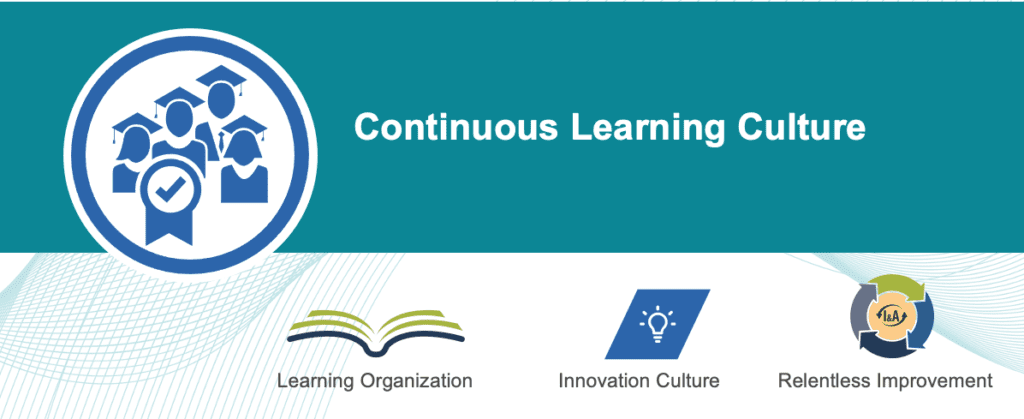Welcome to the final post in our series on learning networks. In previous posts, we’ve discussed the power of informal learning networks, how informal learning networks emerge, and how to uncover these networks in your own organization. In this post, I’ll explain how to connect your learning networks with SAFe®.

I like to think of these learning networks as essential tools in the toolbox of a SAFe enterprise as it works to create a continuous learning culture. Formal events are valuable, intentional, and complement a shift from formal to informal learning opportunities. Creating learning—or serendipitous—moments catalyze a change in mindset with curiosity at the forefront.
A Learning Mindset
Everyone is always learning, all the time, and creating a continuous learning culture is paramount to acknowledging that.
The informal learning networks I’ve been describing align nicely with the three dimensions of a continuous learning culture.
- Become a learning organization. Formal and informal learning networks can help you get there. Informal learning networks are a grassroots-level way to create a learning organization, without anyone actually realizing it.
- Create an innovation culture. Do your teams have the time and space to work on different, unique things and learn from each other? People in these networks are meeting, learning, and innovating together.
- Cultivate a relentless improvement mindset. People in these informal learning networks are curious and always looking to get better at what they’re doing. Relentless improvement is how they think and part of who they are, and they’re meeting, learning, and improving together.

Creating a continuous learning culture is about more than learning how to code in a new system. People want to learn how to coach their leaders, how to mentor people, how to share what they’ve learned, and how to become lifelong learners in the process. And this culture enables people in a Lean-Agile enterprise to solve challenges behind the scenes. In my last post, I wrote about how people in informal learning networks aren’t interested in recognition. They’re passionate about learning new things and applying what they’ve learned to the enterprise. They seek out others with the same mindset, and that’s how the learning mindset and culture grows which is better for any organization and its success without doing much.
How SAFe Promotes Learning Networks
The fact that an organization has adopted SAFe in the first place is a catalyst for promoting these learning networks. So, where in SAFe do these learning networks appear? And where are the opportunities for informal learning networks to emerge as enterprises adopt SAFe, business agility and sustain their transformation over time? Let’s do some exploring.
Communities of practice
The best communities of practice (CoPs) I participate in don’t have a full, formal agenda. Instead, they leave space for thoughts and ideas to surface. CoPs don’t exist for people in similar roles to get together once a month with a guest speaker. Rather, they exist to organically create tremendous learning opportunities and thriving social networks.
Before I left my last enterprise, I was an SPC at the time, and I started a CoP for all the SPCs across the organization. There were a lot of us, and I’m still active in a few informal learning networks that started from this CoP, as well as other CoPs that crossed organizational boundaries. Many informal networks start from the most casual conversations and events, some with just a few people, and expand from there—within and outside the organization.
Continuous learning culture
Fostering a continuous learning culture isn’t about checking boxes, bringing in external trainers, or transactional learning. It’s about tying these elements together from formal and informal events. And I remember being part of an organization that was great at this.
One time in particular, there was a fairly large internal Agile conference organized in one of our Texas offices. As a speaker for this event, I got to meet so many other coaches and agilists from business units that I didn’t even know existed in our enterprise. It was an amazing experience. The event launched numerous social networks that turned into learning networks for me—many that I’m still part of. Other times, less-formal events would just emerge. Events like unplanned coaching clinics we’d spin up to help associates discover growth areas that they could focus on within their role. A lot of mentoring relationships even grew from some of these. Suffice it to say, there was no shortage of available learning networks to lean into. Once I joined them, my traditional perspective about having to go outside of my organization to learn just disappeared.

IP iteration
The innovation and planning (IP) iteration is a perfect opportunity to build and expand informal networks. People typically have more time and space to explore and focus on something other than their day-to-day work. Oftentimes, we see leaders try to take this iteration off the schedule and go directly from one PI to another. There isn’t a pause for innovation or learning or preparing for the next PI. This is why I think the IP iteration is non-negotiable and should be a promise that all leaders make to their ARTs.
I’ve seen so many learning networks emerge during IP iterations, including from hackathons. After the hackathon demo, people that are curious about the outcome and want to lean in and help take it forward, often (quite informally) start a learning network. Maybe they put some stories on a backlog. Maybe they decide to extend the network to more people outside of their teams and ARTs. That’s exactly how these networks start and grow.
What’s so great about learning networks is that you can meet with anyone from anywhere internal and external to your organization. You can create a protected space where people can connect and find new ways to improve their skills. Everyone can learn together from practicing SAFe.
Informal Learning Networks: Find One. Join One. Start One.
I participate in a number of informal networks. Some of them originated from past enterprises where I worked. Some of them originated from Agile conferences. Some of them originated from other formal facilitation groups that I’m part of. But they all share a key characteristic: the only constraints that exist are the ones that we may place on them ourselves.
At one time, I had four mentors that emerged from my learning networks. And from each one of those relationships, I created new, informal learning networks. I couldn’t wait to keep sharing what I learned, including practicing new skills. I wasn’t the only one who had external mentors, so I got to learn from others in the networks too. By joining all these learning networks, I sharpen my skills, and extend them in areas where it used to take me twice as long to do something. But now that I’ve learned from others, I can work smarter. The biggest benefit? It doesn’t actually feel like work when you’re part of a learning network.
In the first post I wrote for this series, I described the moment when I shifted from being a transactional learner to a lifelong learner after my leader told me to, “Just keep doing what you’re doing.” In your quest to be a lifelong learner, I expect that many of you are already part of an informal learning network—you probably just didn’t have a name for it.
I challenge and encourage you to find someone in your enterprise who’s interested in the area that your learning network is currently exploring. Invite them to collaborate with you. Although these networks are informal, they’re still open to everyone.
Here’s my advice around finding, joining, and creating a learning network:
- Be curious.
- Seek out a learning network. Find out how it started and what members are learning about. I can almost guarantee you won’t find a calendar entry for it.
- Join a learning network. But not the first one you come across. Find one whose members are exploring and learning something you’re passionate about.
- Start a learning network. All of us have topics that really excite us. What’s the one thing you spend your weekends learning more about? And how can you contribute your knowledge, expertise, and experience to help others learn? Start a learning network by bringing what you know into your daily collaborations at work. Chances are once you start sharing what you’re learning, people will come to you.
I truly believe that learning networks are a best-kept secret in organizations. Primarily because they catalyze learning and help organizations cultivate a continuous learning culture. What will you learn next?
About Audrey Boydston

Audrey Boydston is a senior consultant at Scaled Agile and an experienced SPCT, Lean-Agile coach, trainer, and facilitator. Her work focuses on continuous learning, building fundamentals, re-orienting around principles, and helping clients—from senior executives to developers—build networks and communities that support their transformations.
Share:
Back to: All Blog Posts
Next: Launching an ART? Do a Gemba Walk.